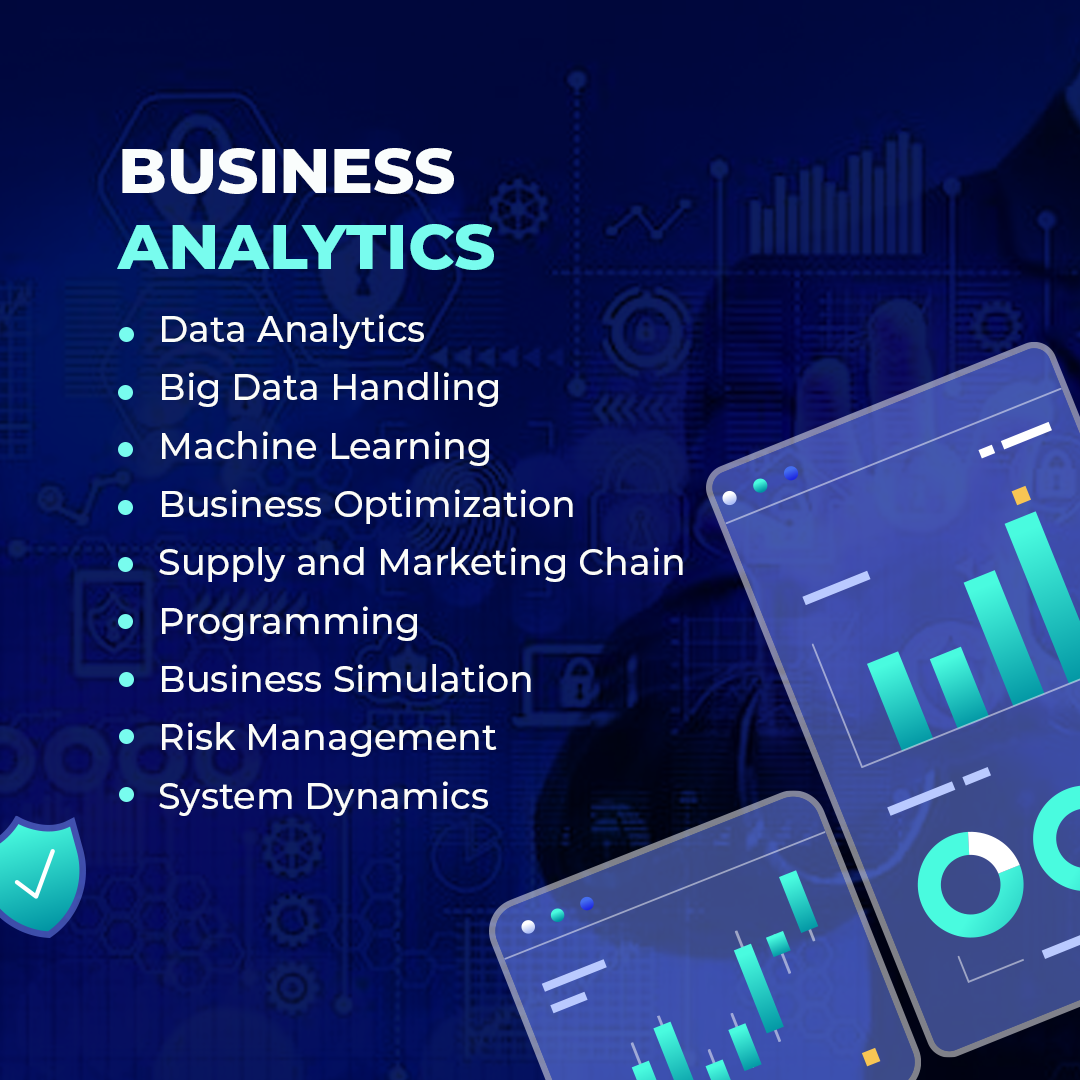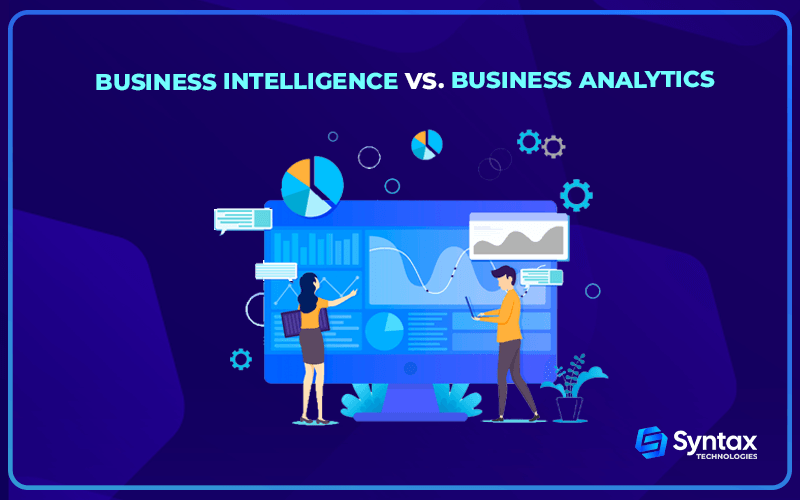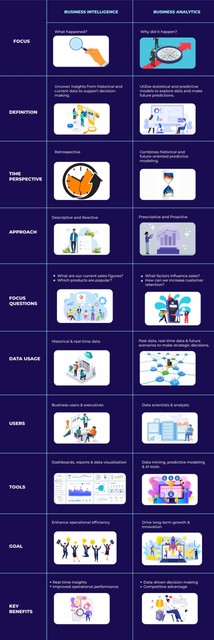In the modern business landscape, data has become the currency of success. Companies are increasingly turning to data-driven decision-making processes to gain a competitive edge and drive growth. Two essential disciplines that play a crucial role in this data-centric approach are Business Intelligence (BI) and Business Analytics (BA). While they are often used interchangeably, they serve distinct purposes and have unique characteristics.
In this blog, we will delve into the world of BI and BA, highlighting their differences and understanding how they contribute to the success of organizations.
What is Business Intelligence?
Business Intelligence (BI) is a technology-driven practice that involves the collection, integration, analysis, and presentation of business information. Its primary purpose is to enhance the decision-making process by providing stakeholders with actionable insights based on past and current data.
It encompasses various tools, applications, and methodologies that allow organizations to collect data from internal and external sources, prepare it for analysis, develop and run queries against the data, and create reports, dashboards, and data visualizations.
Through these, organizations can interpret their data and make well-informed and strategic business decisions.

Articles you may like:
What Are The Key Benefits Of Business Intelligence In Modern Organizations?
Business Intelligence in IT Industry
What is Business Analytics?
Business Analytics (BA) is a more advanced approach of handling business data, involving statistical analysis, data mining, predictive modeling, and machine learning to analyze data and generate future-oriented insights.
BA helps businesses to predict future trends, identify potential opportunities, and make proactive, data-driven decisions. It takes a deeper look into the causes of certain results and outcomes, providing a predictive and prescriptive analysis.
While BI focuses mainly on what happened and what is happening in the present, BA seeks to answer why it happened and what could happen in the future. This approach is more proactive, aiming to provide strategic solutions for business growth and development.

Understanding the Roles of Business Intelligence and Business Analytics
Both Business Intelligence and Business Analytics play pivotal roles in enhancing a company’s decision-making capabilities. The role of BI is to track, process, and analyze data related to past and present business operations. It provides a holistic view of the organization’s historical data, helping stakeholders understand where they’ve been and where they stand currently.
Dashboards, reports, and data visualizations are typical outputs of BI, aiding in the monitoring of key performance indicators (KPIs), recognizing market trends, and optimizing current business practices.
On the other hand, Business Analytics is forward-looking, using statistical analysis and predictive modeling to make educated guesses about future trends. It delves deep into the data to uncover patterns and correlations, providing insights into why certain outcomes occurred and what could occur in future scenarios.
BA guides strategic planning by identifying opportunities for growth, predicting customer behavior, and assisting in risk management.
The Difference Between Business Intelligence and Business Analytics
In this section, we shall undertake a comparative analysis between the two processes along certain definite criteria.
- Definition and Scope:
Business Intelligence (BI): BI involves the process of collecting, analyzing, and presenting raw data to support better decision-making within an organization. It focuses on the retrieval and transformation of data into meaningful insights and reports.
Business Analytics (BA): BA, on the other hand, goes beyond BI by utilizing statistical and predictive models to explore past data and extract insights that drive future-oriented strategies. It aims to uncover patterns, trends, and relationships in data to make informed predictions and optimize business processes.
- Purpose:
Business Intelligence: The primary purpose of BI is to provide a descriptive view of the data, offering a snapshot of what has happened and what is currently happening within the organization. It enables stakeholders to understand the current state of affairs and monitor business performance.
Business Analytics: BA, on the other hand, is more focused on prescriptive and predictive analysis. It seeks to answer “why” things happened and “what if” scenarios to inform decision-makers about potential outcomes and suggest the best course of action for the future.
- Time Perspective:
Business Intelligence: BI is typically retrospective in nature, dealing with historical and current data. It helps identify trends and patterns over time, allowing businesses to learn from the past and adjust their strategies accordingly.
Business Analytics: BA looks both backward and forward. While it also utilizes historical data, it heavily relies on predictive modeling to anticipate future trends and events, enabling businesses to proactively plan for upcoming challenges and opportunities.
- Technical Complexity:
Business Intelligence: BI tools are generally user-friendly, focusing on data visualization and dashboards that are accessible to a broad range of users. It may not require advanced technical skills to extract insights from BI systems.
Business Analytics: BA involves more complex statistical and data mining techniques. Data scientists and analysts often work on building and implementing predictive models, requiring a deeper understanding of data science and statistical methods.
Benefits of Having a Good Understanding of Both Models
The combined understanding and application of both Business Intelligence (BI) and Business Analytics (BA) can significantly enhance an organization’s decision-making process and strategic planning. By integrating BI and BA, companies can gain a comprehensive understanding of their historical and current performance (through BI), while also predicting future trends and formulating proactive strategies (through BA).
This synergy allows for a more holistic approach to data management and decision-making. Companies are able to monitor their real-time performance, identify areas of improvement, and adjust their strategies based on concrete data. At the same time, they can anticipate market trends, predict customer behavior, and shape strategic initiatives accordingly.
Having a good grasp of both models also allows for a more flexible use of data. Depending on the specific requirements of a situation, organizations can leverage either BI’s descriptive capabilities or BA’s predictive power, or combine both for a comprehensive data analysis.
Conclusion
In conclusion, both Business Intelligence and Business Analytics are indispensable tools in the modern business landscape. While they may differ in approach and scope, they complement each other in providing a comprehensive picture of an organization’s status and its future trajectory.
By leveraging the strengths of both models, an organization can enhance its decision-making process, optimize its business operations, and remain competitive in an increasingly data-driven market. This synergy between past and future, between description and prediction, is what makes the integration of BI and BA a strategic imperative for businesses today.
We, at Syntax Technologies, help you develop as a BI expert by cultivating the requisite skills. Enroll today.


